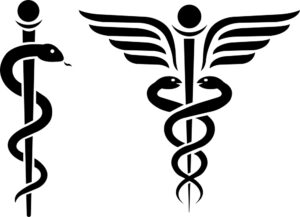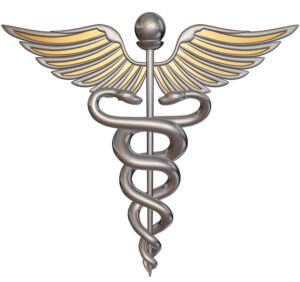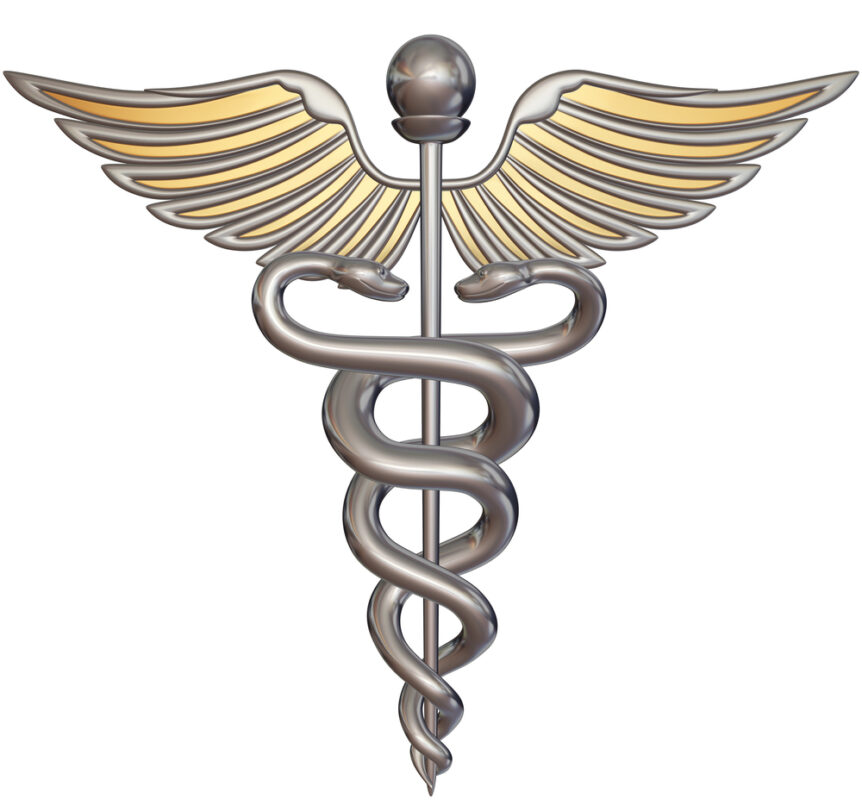Writing About the Caduceus: The Confused Caduceus

Are there two caduceuses?
Well, technically no. There are two ancient pagan symbols with either one or two snakes wrapped around a pole or a tree, and you will see both used in logos for medical practices, healthcare organizations, hospitals, medical associations, nursing and almost anything to do with medicine. If you’re writing about a caduceus or using it in an image such as a book cover, you need to know only one of these two is the correct one.
In medical school, we were told the caduceus represented the symbol of Asclepius, a Greek god of healing. The design shown on the overhead display for our class was one of the above – a snake wrapped around a pole, or two snakes with wings on either side above.
I had learned about it as a child, studying my mom’s nursing pin from Marion County General Hospital School of Nursing, which looked exactly like this one from an antiques website. Mom explained the snake wrapped around the tree was called a caduceus. A nurse’s outline was the other part.
I didn’t realize until I researched this article the nurse was offering a small cup to the snake. The small pharmacy-style cup is the symbol for Hygieia, the Greek goddess of health, cleanliness and hygiene, and that was another common symbol for healing in the ancient world.
The Truth:
Caduceus actually refers to the staff of Hermes/Mercury the messenger, and the single snake symbol is properly called the Rod of Asclepius.
As it turns out, two ancient symbols involved snakes on a pole. (not snakes on a plane, a very different thing) Mercury/Hermes, the ancient messenger god with winged feet, carried a staff with two snakes wrapped around it and a wing placed on either side at the top.
Asclepius, son of Apollo, was a god of healing and his symbol was a single snake wrapped around a stake, like the one in the story of Moses and the miracle of the in thBronze Serpent. The Children of Israel had fallen into idolatry and were punished by “fiery serpent bites” which were fatal. I find it interesting that the Rod of Asclepius was said to heal snake bites, which to me hearkens back to Mosaic times. (which I believe predates the Greek version)
8 The Lord said to Moses, “Make a snake and put it up on a pole; anyone who is bitten can look at it and live.”
9 So Moses made a bronze snake and put it up on a pole. Then when anyone was bitten by a snake and looked at the bronze snake, they lived.” Numbers 21:4-9.
Imagine my surprise when I learned the modern caduceus symbol used by many medical associations and even the Surgeon General and the Army Medical Armed Corps of the United States is wrong.
One theory for the modern mix-up is the choice in 1902 of a symbol for the original Army Medical Corps. The one used was the double snake with wings, the symbol for Mercury. It is more photogenic and appealing with its symmetry.
I’m happy to report the American Board of Family Medicine, of which I’m a member, has the correct single snake symbol in its logo.
If you plan to use a caduceus symbol on a book cover, blog, promo or other material, you can use either one – but at least you’ll know which one is the “correct” one.
Honestly, this one really IS more appealing . . . .

References:
“Caduceus and Rod of Asklepios: A Tale of Two Rods.” Mohamed Muhtaseb, Aaya Mutaseb. Correspondence, Eye (2022) 36:2226–2227.


